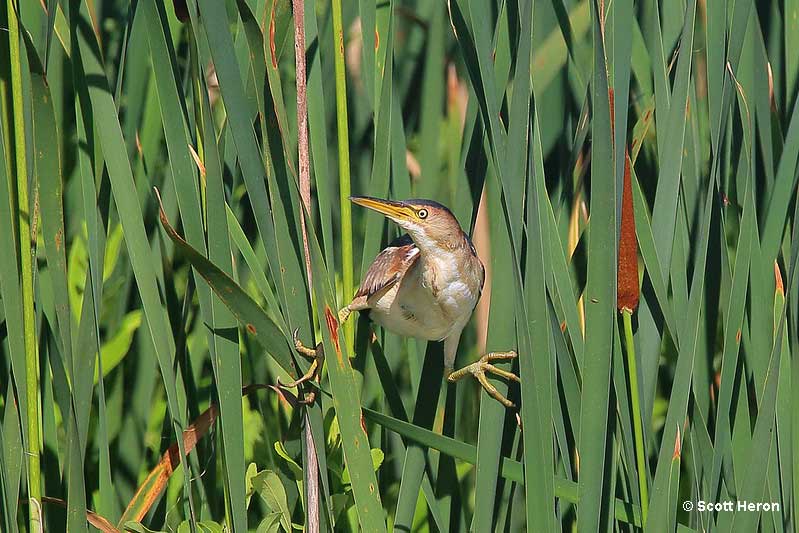The Least Bittern is a very small heron. They have daggerlike bills, long necks that they often keep drawn in, and long legs and toes, giving them a hunched appearance. These birds may raise the neck and crown feathers when they are agitated.
Least Bitterns can be found in brackish or freshwater marshes with tall, dense vegetation like cattail or other reeds.
Walk slowly and pause to listen for the quiet, rapid, coo-coo-coo-coo song of male Least Bitterns.
The development and drainage of wetlands have reduced this bird’s population, but they persist over much of their historical range.
On this page
Breeding Male
Breeding male Least Bitterns look pale below and blackish above from a distance.
Viewing these birds closer up will show that adult males have two white stripes along their backs. They’re clad in black, buff, and chestnut, with the males being more richly colored than the females.
These birds are 11.0 to 14.2 inches (28 to 36 centimeters) long and weigh 1.6 to 3.4 ounces (46 to 95 grams). Least Bitterns are smaller than Green Herons but larger than Red-winged Blackbirds.
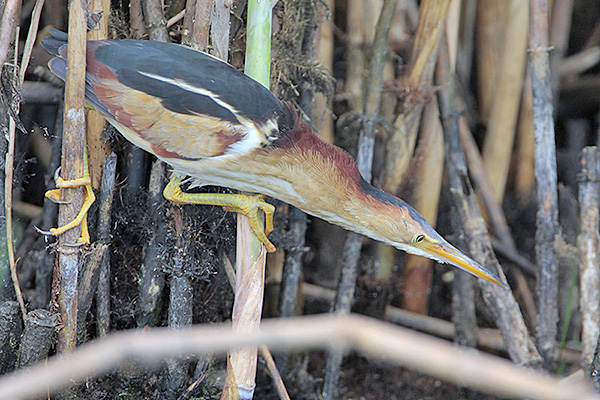
Photograph © Greg Lavaty
Female
Female Least Bitterns look similar to male Least Bitterns, with some differences. They’re clad in black, buff, and chestnut, with the females being more uniformly buff or brownish.
They are roughly the same size.
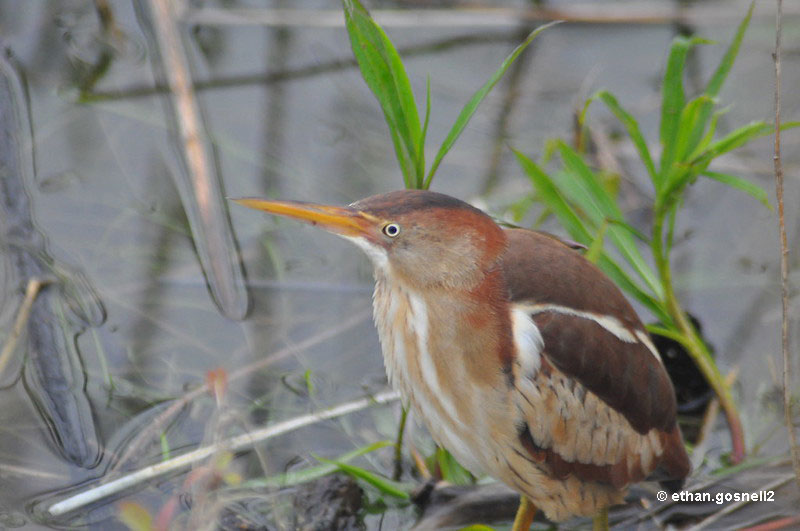
Female Least Bittern. Photograph © ethan.gosnell2
Juvenile
Fledgling Least Bitterns are chestnut or dark rusty overall. In juveniles, which can be seen in late summer and autumn, many of their feathers are cleanly edged with rufous and buff, giving them a scaly appearance above.
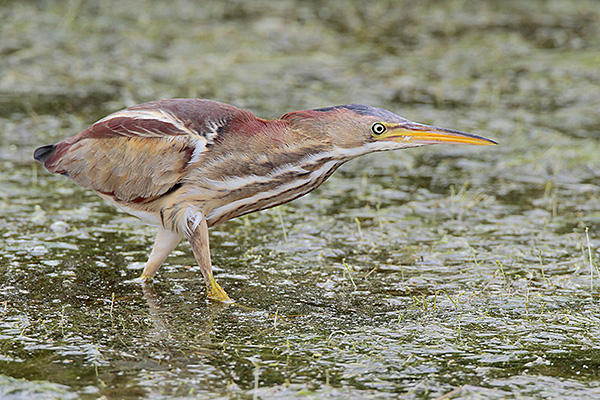
Photograph © Greg Lavaty
It takes around 50 days for Least Bitterns to hatch, and they’ll leave the nest when they’re 5 to 9 days old. Once they leave the nest, they hunt for themselves.
Habitat
Least Bitterns are fairly scarce breeders in inland and coastal wetlands. However, they can be numerous locally where food is plentiful.
These birds nest in brackish and freshwater marshes with tall aquatic vegetation and rushes with small interspersed stands of woody vegetation and open water.
Some Least Bitterns forage in mangrove swamps and saltmarshes during the summer months, but they only nest in these habitats sometimes.
Least Bitterns spend the winter months in freshwater, brackish, and saltwater wetlands in the southernmost coastal areas of their range in North America, including southern Florida, Texas, Mexico, Central America, and the Caribbean.
Diet
Least Bitterns primarily consume small fish like sunfishes, perches, and minnows. They also eat frogs, small snakes, tadpoles, slugs, salamanders, shrews, crawfish, mice, leeches, and dragonflies. They’ll sometimes prey on young Yellow-headed Blackbirds or Yellow-headed blackbird eggs.
When hunting, the birds either hang or stand from reeds and remain motionless near the water’s edge. When prey swims by, they’ll jab at them with their bill. Sometimes Least Bitterns will stalk their prey by walking slowly. You may even see them sway their neck side to side right before they strike.
Additionally, these birds may flick their wings to startle prey hiding into the open.
Behavior
Least Bitterns are lone hunters; they quietly perch at the edge of reeds and watch for prey.
Their movements are deliberate and slow when climbing or walking, and they often grasp reeds with their feet when moving above the ground.
These birds can run rapidly and compress their bodies to help them maneuver through dense vegetation.
Flying Least Bitterns appear delicate; they rise above the reeds, quickly flutter downward, and disappear into foliage. On longer flights, their heronlike shape is unmistakable.
When these birds feel threatened, they’ll hiss, open their bills, and tilt their wings forward.
Range (and seasonal changes)
Least Bitterns are medium- to long-distance migrants. Their range starts from southern Canada, extends all the way down to Florida, and west to Kansas. In the winter months, Least Bitterns are found in Panama, California, Columbia, Florida, and Texas.
Wing shape
Least Bitterns have short, broad, rounded wings and a wingspan of 16.1 to 18.1 inches (41 to 46 centimeters).
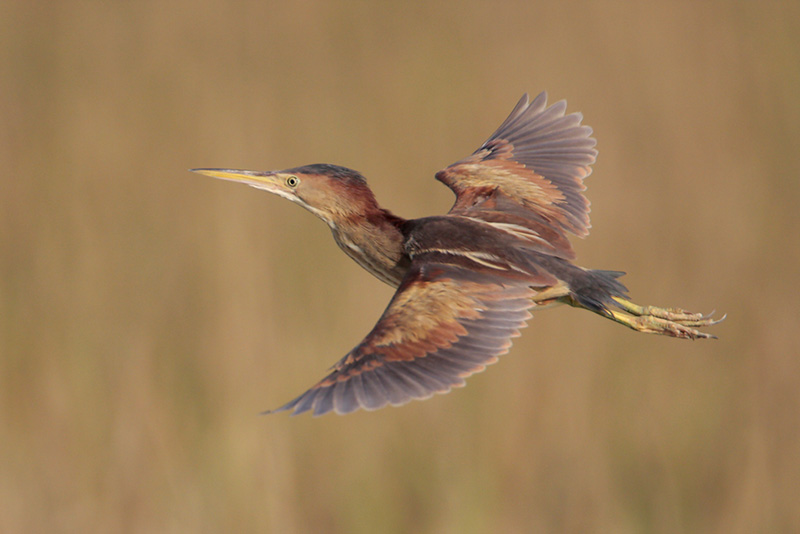
Least Bittern in Flight
Fun Facts
- Least Bitterns are one of the smallest herons in the world. They’ve adapted for life in dense marshes rather than wading in the shallows. These birds climb in reeds and cattails and cling to the stems with their long toes. Their narrow bodies allow them to easily slip through tangled, dense vegetation.
- Least bitterns are carnivores. Their diet consists of frogs, small fish, salamanders, crayfish, slugs, and insects.
- When Least Bittrerns detect danger, they’ll freeze in place, erect their bills upwards, and sway in the wind like a reed to fool predators such as red-tailed hawks and snapping turtles.
- Female Least Bitterns can lay 2 to 7 eggs per brood. The average is 4 to 5. Both the male and female will participate in the incubation, which lasts 16 to 18 days.
- The average lifespan of Least Bitterns in the wild is 6 years.
Call
In the spring, male Least Bitterns sing a quiet, subtle coo-coo-coo-coo from hidden locations to mark their territory and attract mates. Least Bitterns make various calls, including a rail-like gak-gak! that serves as a contact call between mates, a ticking sound made by a responsive female in response to a singing male, and other clucks, cackles, shrieks, and hisses. These calls are most likely a response to predators.
Similar Species
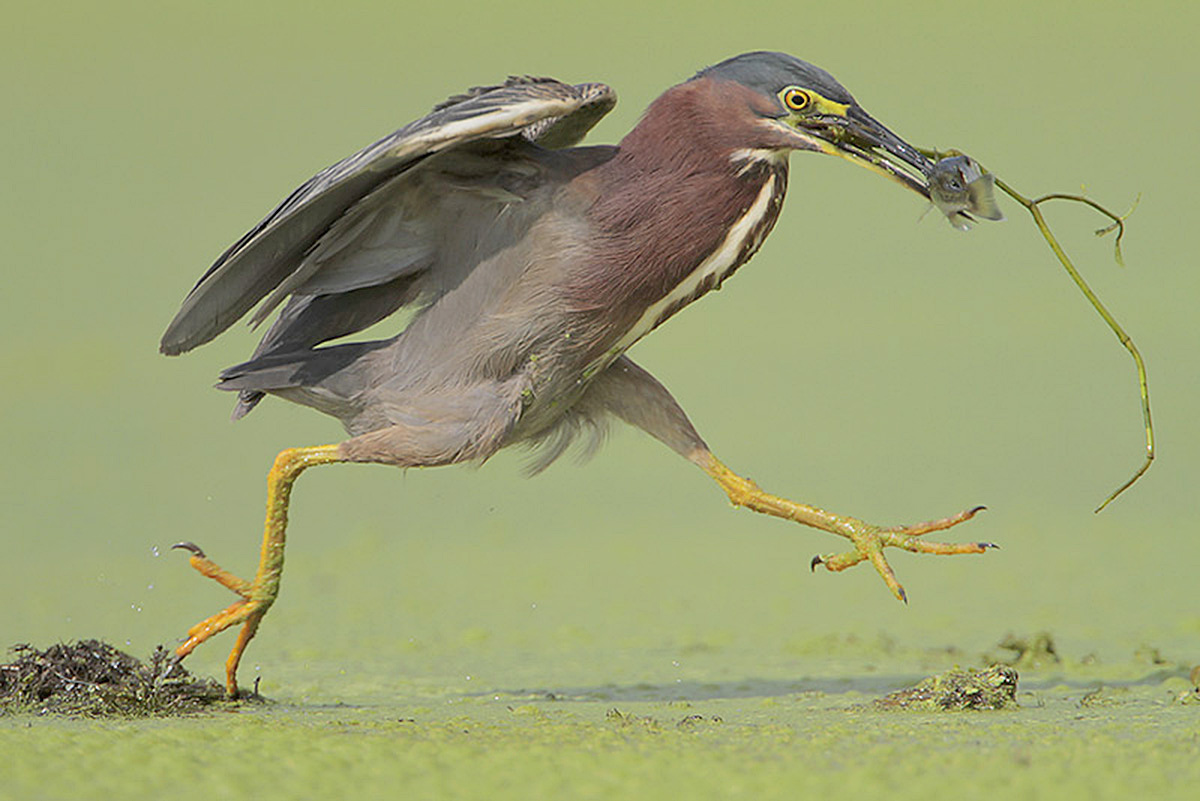
Green Heron. Photograph © Greg Lavaty.
Compared to Least Bitterns, Green Herons have more grayish blue-green plumage. Least Bitterns have brownish chests and bellies, while Green Herons have darker brown necks and grayish bellies.
It’s worth noting that their legs and bills look different too – Least Bitterns have yellowish bills and legs, while Green Herons have yellow or orange legs and dark gray bills.
Green Herons tend to be a bit bigger as well.
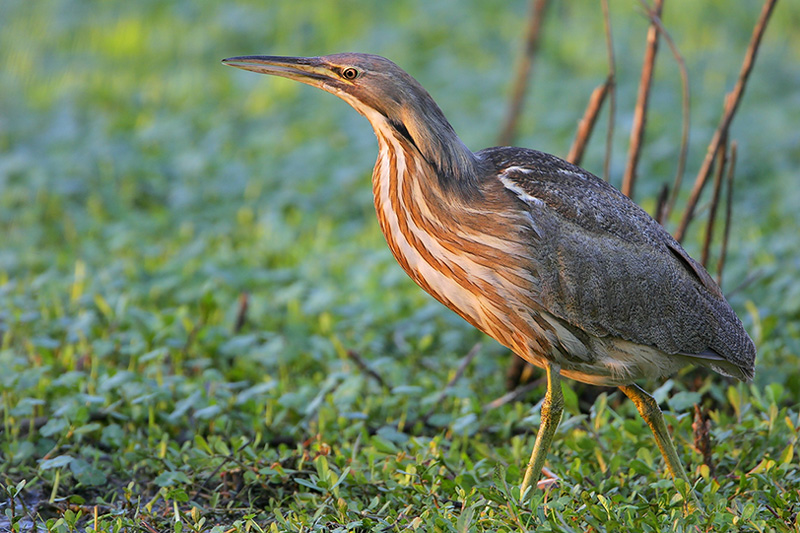
American Bittern
Least Bitterns are noticeably smaller than American Bitterns. American Bitterns are almost double their size.
Plumage-wise, American Bitterns have brownish plumage all over their body, with some stripes running down their necks, while Least Bitterns can have some stripes too, but they are not as noticeable.
American Bitterns have brown plumage on their whole bodies, while Least Bitterns have grayish tones on their backs.
Frequently Asked Questions
What is the difference between Least Bittern and American Bittern?
Least Bitterns are much smaller than American Bitterns. Additionally, Least Bitterns cling to marsh vegetation, while American Bitterns stand in wetland marshes.
Where are Least Bitterns found?
These birds nest in brackish and freshwater marshes with tall aquatic vegetation and rushes that have interspersed small stands of woody vegetation and open water. Some Least Bitterns forage during the summer months in mangrove swamps and saltmarshes, but they don’t nest in these habitats as often. Least Bitterns spend the winter months in freshwater, brackish, and saltwater wetlands in the southernmost coastal areas of their range in North America, including Texas, southern Florida, Mexico, Central America, and the Caribbean.
How long do Least Bitterns live?
The average lifespan of Least Bitterns in the wild is 6 years.
Why is Least Bittern endangered?
Least Bitterns are not endangered; however, their populations have been thought to have declined in many areas because of the destruction of marsh habitats. Runoff of chemicals from agricultural fields into standing marshes is another potential problem. However, these birds are still abundant in some parts of North America.



